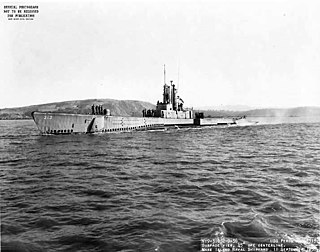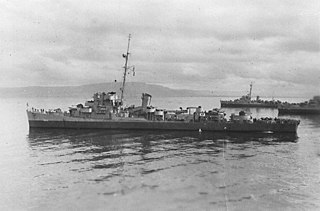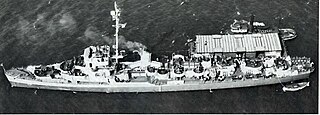
USS Kleinsmith (APD-134), ex-DE-718, was a Crosley-class high speed transport for the United States Navy. She was named for Chief Watertender Charles Kleinsmith (1904–1942), who was posthumously awarded the Navy Cross for his heroism during the Battle of Midway.

USS Talbot (DD-114) was a Wickes-class destroyer in the United States Navy during World War I and later designated APD-7 in World War II. She was the first ship named in honor of Silas Talbot.

USS Perch (SS/SSP/ASSP/APSS/LPSS/IXSS-313), a Balao-class submarine, was the second submarine of the United States Navy to be named for the perch, a freshwater spiny-finned fish.

USS Gilmer (DD-233/APD-11) was a Clemson-class destroyer in the United States Navy during World War II. She was the first ship named for Secretary of the Navy Thomas Walker Gilmer.

USS Humphreys (DD-236/APD-12) was a Clemson-class destroyer in the United States Navy during World War II. She was named for Joshua Humphreys, a pioneer US shipbuilder.

USS Schmitt (DE-676) was a Buckley-class destroyer escort in the United States Navy, commissioned in 1943. In late 1944, she was converted to a high speed transport and was redesignated APD-76. She was retired in 1949 and transferred to the Republic of China Navy in 1969, where she served as ROCS Lung Shan (PF-44) until 1976, when she was scrapped.

USS Bull (DE-693/APD-78) was a Buckley-class destroyer escort, later converted to a Charles Lawrence-class high speed transport. She was the second Navy ship named after Lieutenant Richard Bull (1914–1942), a naval aviator who was posthumously awarded the Distinguished Flying Cross.
USS Cavallaro (DE-712/APD-128) was a Crosley-class high speed transport of the United States Navy.

USS Cook (APD-130) was a Crosley-class high speed transport of the United States Navy, named after two brothers: Second Lieutenant Andrew F. Cook, Jr. (1920–1942) and Sergeant Dallas H. Cook (1921–1942). Both served in the Marine Corps, and both were awarded the Navy Cross, posthumously.

USS Walter X. Young (DE-715/APD-131) was a ship of the United States Navy, named for Lieutenant Walter X. Young (1918–1942), an officer of the United States Marine Corps who was killed in action during the Battle of Guadalcanal.

USS Burdo (APD-133) was a Crosley-class high speed transport of the United States Navy, in service from 1945 to 1958. She was finally sold for scrap in 1967. Burdo was named after Private Ronald A. Burdo (1920–1942), a Marine who was killed in action at Gavutu, during the Battle of Guadalcanal.

The USS Weiss (APD-135/LPR-135) was a Crosley-class high speed transport in service with the United States Navy from 1945 to 1970, with two short periods spent in reserve. She was finally scrapped in 1976.

USS Gantner (DE-60/APD-42), a Buckley-class destroyer escort of the United States Navy, was named in honor of Boatswain's Mate Samuel Merritt Gantner (1919-1941), who was killed in action during the Japanese attack on the Hawaiian Islands.

USS George W. Ingram (DE-62/APD-43) was a Buckley-class destroyer escort in service with the United States Navy from 1943 to 1947. In 1967, she was transferred to Taiwan, serving as Kang Shan until being scrapped in 1979.

USS Loy (DE-160/APD-56), a Buckley-class destroyer escort in service with the United States Navy from 1943 to 1947. She was converted to high-speed transport (APD) in late 1945. Following her decommissioning, she spent another 19 years in reserve before being sold for scrap in 1966.

USS Lloyd (DE-209/APD-63), a Buckley-class destroyer escort of the United States Navy, was named in honor of Ensign William R. Lloyd (1916–1942).

USS Burke (DE-215/APD-65), a Buckley-class destroyer escort of the United States Navy, was named in honor of Lieutenant Commander John E. Burke (1905–1942), who was killed in action, aboard the battleship South Dakota during the Naval Battle of Guadalcanal on 15 November 1942.

USS Bowers (DE-637/APD-40) was a Buckley-class destroyer escort of the United States Navy, was named in honor of Ensign Robert K. Bowers (1915-1941), who was killed in action aboard the battleship USS California during the Japanese attack on Pearl Harbor on 7 December 1941. The ship was laid down on 28 May 1943 at San Francisco, California, by the Bethlehem Steel Company; launched on 31 October, sponsored by Mrs. Eunice Bowers, the mother of Ensign Bowers; and commissioned on 27 January 1944. The ship served in World War II in the Pacific

USS Hollis (DE-794/APD-86) was a Buckley-class destroyer escort in service with the United States Navy from 1944 to 1947 and from 1951 to 1956. She was scrapped in 1975.

USS Earle B. Hall (APD-107), ex-DE-597, was a United States Navy high-speed transport in commission from 1945 to 1946, 1950 to 1957 and 1961 to 1965.



















